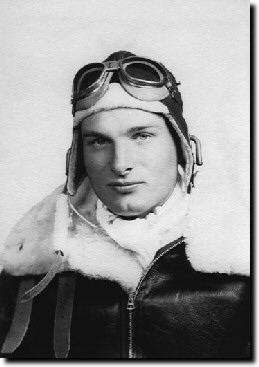![]()
Memories
of My Time With the 320th B.G. During WW II
by
Donald Wilson Round, 444th Bomb Squadron
|
|||||
|
|
I said something about South America to my daughters and they said, "You have never been there". I replied, “Yes I have - during the war”. When my daughters were young they were not interested in what I did during the war. I always wished I had asked my father what he did at the Panama Canal, and how he survived the 1900 hurricane and flood in Galveston, Texas.
I am a little different than my brother Arthur as far as the war was concerned. He wanted to be a forester - I wanted to fly! I spent two years at Bakersfield Junior College in California to get enough credit so the government would pay me to fly. In 1940, President Roosevelt wanted 50,000 pilots trained in case of war so he set up the Civilian Pilots Training Program which I took my second year in college at Bakersfield. I was taking flying lessons at Bakersfield when the war started. While I was there, the government created a 150-mile defense zone from the coast, so I had to finish my flying lessons in the Mojave Desert near Mt. Whitney. I earned my Pilots license before I joined the Air Force. Since I was not old enough my sister Mary signed the papers so that I could join the Air Force. I enjoyed my Air Force training; they gave us the best of everything. I had a good time and plenty to eat. My brother and I were a little short on eating for a couple years at Bakersfield. In cadet training, they gave us a dollar a day for meals compared to 21 cents a day for GIs. I joined the Air Force in Bakersfield and took the test to be a cadet. The test was easy and so was my training in the Air Force ground school. At Bakersfield the night Civilian Pilots Training school was better than what I had in the Air Force, so ground school was very easy for me. We had a lot of time off and San Antonio was a pretty good place to spend it. After I received my commission, my orders were to report to Avon Park Bombing Range in Florida for B-25 training. When I arrived all they had were B-26s. The B-26s had the name of being "widow makers" and "a plane a day in Tampa Bay". Another pilot that I knew from training reported to headquarters same time I did, the adjutant said "Good to see you, we need an Officer of the Day". We told him we had just graduated from cadet school and we didn't know anything about being an Officer of the Day. He told us, "Well, flip a coin. One of you is going to be the Officer of the Day, see that jeep out there, that Sergeant in it knows what to do". I won the coin toss that time, but I was Officer of the Day twice while I was stationed at Tyndall Field Florida. As Officer of the Day I had to check the stockade to see if all the prisoners were accounted for. This was a first time experience for me. One day I was Tower Officer of the Day and things were going fine until a captain called to tell me I was keeping the P-39 airplanes on the ground waiting for take off too long. I thanked him for the information and told him that this was the first time I had ever been Tower Officer. My fiancé, Charlyne Jane Campbell, came down to Avon Park in August of 1943. We were married in Lake Wales, Florida on 15 August 151943. I had to get Lt. Birmingham to fly in my place so I could get married. We had our marriage picture made at Lake Wales, Florida but the studio had to pick out the best one because I was transferred to Elgin Field, Florida for torpedo training. I am glad we never had to drop torpedoes from a b-26 airplane. While at Elgin Field I saw the first B-29 airplane being tested there. It was quite a sight. Next I was transferred to Lake Charles, Louisiana for a short time and then to Savannah, Georgia to prepare to pick up airplane to fly overseas. At Savannah we picked up our equipment and made checks of our airplane. One such check was a compass check on a piece of railroad track that ran straight for 21 miles north of Savannah. They gave us south sea equipment one day and the next day they took it all back and gave us equipment for Africa and Europe. (Continued) |
||||

Copyright(c) 2003 320th History Preservation. All rights reserved.




















